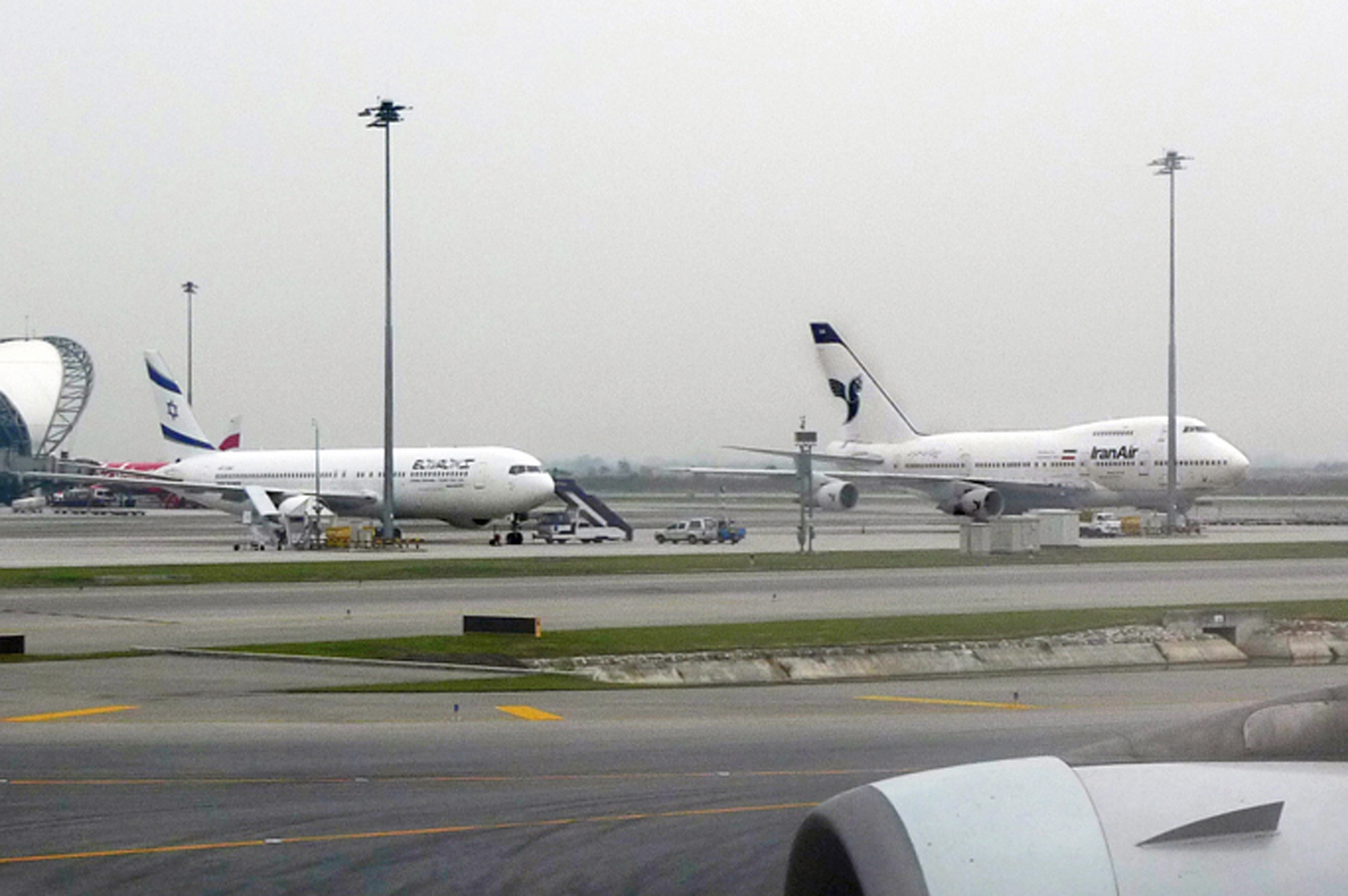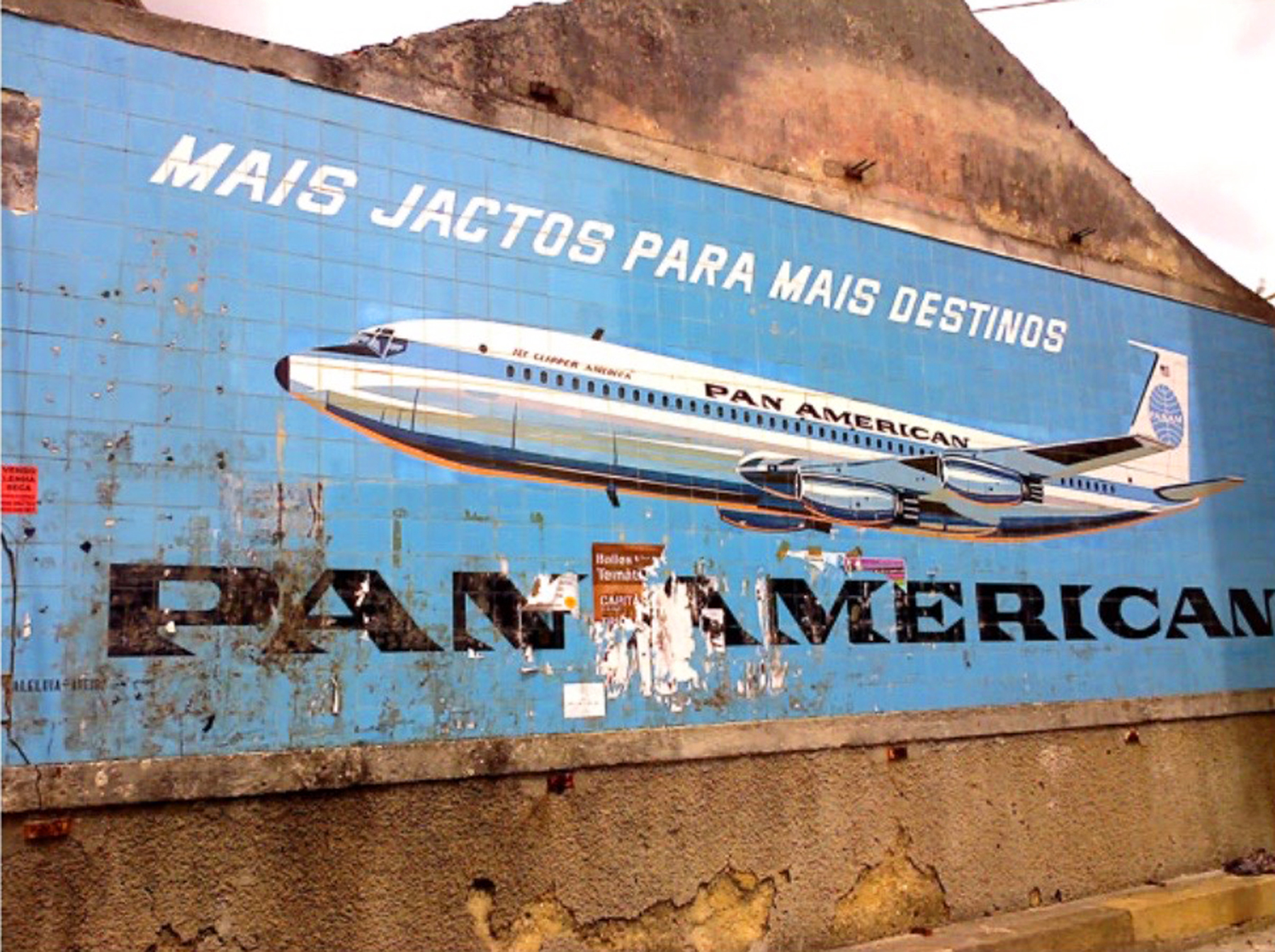Crossovers
When Culture and Air Travel Intersect
Crossovers. That’s my name for those moments when history, culture, art or politics intersect unexpectedly with commercial aviation. They underscore the many ways, not always recognized, that air travel touches our lives.
This will be an ongoing series. I’ll add to it as opportunities come up.
— NEW: AEROPOLITICS

This one speaks for itself. A 767 of El Al, the Israeli carrier, buddy-buddy with an Iran Air 747 at Bangkok’s Suvarnabhumi Airport. I took this photo a decade ago, but the theme couldn’t be more timely.
Was this by accident, do you think, or were the authorities at BKK pushing for a sort of tarmac detente?
It’s hard to imagine, but in the days before the revolution in Iran, El Al flew scheduled service between Tel Aviv and Tehran. Iran Air had routes from New York to Tehran via London and Paris. Somewhere in a box is a picture of an Iran Air 747 that I took at Kennedy Airport in 1979, using an old Kodak Instamatic, from the rooftop parking lot of terminal 3.
Photo by the author
— HISTORY IN BLUE

This mural is in Portugal, near the city of Aveiro. Put up in the 1960s, during the glory days of Pan Am, it remains mostly intact. What makes it special is that it’s constructed using azulejos — the traditional, blue and white glazed tiles seen all over Portugal.
A similar Pan Am billboard can be found on a hillside above the Portuguese town of Leiria. Whether they’re actual azulejos or just painted to look that way I’m not sure. Either way it’s impressive, and Pan Am’s signature colors lend themselves nicely to the azulejo style. To think that so much effort and style was once put into an airline advertisement.
If you’re ever in Lisbon, be sure to visit the Museu Nacional do Azulejo, also known by its boring English name, the Tile Museum. It’s one of the city’s lesser known attractions, but home to one of the world’s largest ceramics collections, full of beautiful murals and mosaics.
Photo by Rui Vaz, courtesy of the Pan Am Historical Foundation.
— TAIL TALE
If you’ve followed the MH370 saga, you’ve no doubt grown familiar with the Malaysia Airlines logo. It’s seen all the time in news posts and articles. What you might assume is a meaningless abstract branding tool is in fact a cultural emblem: the logo uses the shape of an indigenous Malaysian kite known as the wau bulan, or moon kite.

True story: In 1993 I was in the city of Kota Bahru, a conservative Islamic town in northern Malaysia close to the Thai border, when we saw a group of little kids flying wau kites. At the time I didn’t realize where the airline’s logo had come from, but I recognized the pattern immediately. It was one of those crossover moments we aerophiles really savor.
Malaysia Airlines was formed in the early 1970s after its predecessor, Malaysia-Singapore Airlines (MSA), split to become Singapore Airlines and Malaysia Airlines. Both carriers are renowned for their service, and cabin crews of both airlines wear the iconic, floral-pattern Sarong Kabaya batik — an adaptation of the traditional Malay kebaya blouse.




Leave a Comment
Maximum 1500 characters. Watch your spelling and grammar. Poorly written posts will be deleted!
12 Responses to “Crossovers”
You are viewing newest comments first. Click to reverse order
In the Pan Am Museum section of the Cradle of Aviation Museum in Garden City, NY, there’s a model of the Pa Am Worldport terminal at JFK. Among the small models of Pan Am planes is an Iran Air 747 SP along with models of several other non-PanAm airlines that used the terminal.
In ’79 my parents from the Midwest flew to Paris to visit my oldest sister who was on college exchange there. Something very exotic for midwesterners. Their layover was in London where they changed planes and flew Iran Air to Paris. While waiting to board they knew something was “up” as the flight crew had been called to a room to side where my parents could see the concern and tears on their faces as they were being told the revolution had begun. They knew this would be their last flight as free people. The flight took off and was accompanied by the french air force. I’m not sure if I’m retelling the story exactly, but it was a long time ago. Very important moment. Wondered what ever happened to the Iran Air crew.
Patrick,
Off-topic but we’re starting to hear talk of how old and “past normal age” (by which people will surely infer unsafe) 767s flying across the US are today after the slide incident. A quick Google search will return multiple articles.
Given that it’s your equipment type, can we possibly expect a chime-in as part of an upcoming piece?
Safe travels!
Despite these very troubled times, Israeli airliners can be seen on the ramp in Dubai, Abu Dhabi, Casablanca, Cairo, and Amman
El Al can now overfly Saudi Arabia cutting several hours off flight times to Mumbai and Bangkok.
Tel Aviv’s Ben Gurion Airport is now served by Emirates, Etihad, Egyptair, Jordanian, and Air Maroc
A friend of mine had a similar experience observing an Israeli F-16 moving along the Ft Worth production line, followed immediately by an F-16 destined for a neighboring “unfriendly” country (I don’t recall which one). It probably (hopefully) will be the last time those airframes share such proximity.
Have you ever considered doing a piece on the evolution of airplane art? Not the livery on the tail but the equivalent of full-body fuselage tattoos? Think of Braniff’s early artistic streak, followed by everything from Southwest’s orcas to some of the current movie-themed art.
It’s painted tiles.
Re: PanAm mural – Just curious, is that really composed of blue and white tiles or is it paint on blue tiles? (I could not see tile lines delineating the aircraft or the lettering.)
Tom, it does look like an SP, although the foreshortening makes it tough to tell for sure. Wikipedia says that Iran Air had the SP in service up until 2016, so it’s perfectly possible. I believe Iran Air were also the final commercial operators of the 747-100 and -200.
I remember years ago seeing on the ramp at New York-JFK a MEA (Middle East Airlines – Air Liban) Boeing 747 parked not too far away from and El Al 747.
My eyes might deceive me, but the tail fin and aft fuselage of the Iran Air 747 look like an SP. I didn’t think that anyone still flew those as recently as a decade ago.
It is an SP. Iran Air was the last carrier to fly the SP, and did so until 2018.